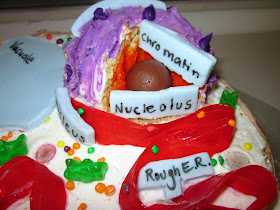Click here to view the lyrics, listen to samples of the songs and/or purchase the music. Today only, you can download a FREE song on the Civil Rights Movement.
Friday, January 27, 2012
Educational Rap: Rhythm, Rhyme, Results has excellent new science songs!
They have SMASHING new songs--The Planets and The Periodic Table of the Elements. My students request the songs regularly. By most accounts, they preferred The Planets right away; some students now are finding that they like the Periodic Table better, but maybe just because that is what we are studying.
Edible Science Model Projects: Part 3--The Periodic Table of Cupcakes!
Our success with the Cell Cakes in 6th year science inspired our 7th years to create the Periodic Table of the Cupcakes which will be occurring next week on Wednesday. Maybe I'll ask Daria Musk to join us in a hangout of the creation!? That would be really fun. I will post photos and a student-edited video when we are done.
Instead of using icing for the writing, we are going to use edible cake pens (found here) and we are making our own Marshmallow Fondant. Why the extra work? The pre-made fondant that you can purchase tastes not-great, and by all accounts this easy recipe makes delectable fondant that you actually enjoy eating, instead of peeling it off the cake (like an orange rind) and then eating it.
Why fondant? Because then we can pre-make the atomic symbol: we can write out the symbol and the atomic number (and mass if we have the space) and then form an assembly line of sorts to put it all together. Theoretically. We'll see.
Anyway, here's the YouTube video that inspired us and the Huffington Post article that describes the video.
Instead of using icing for the writing, we are going to use edible cake pens (found here) and we are making our own Marshmallow Fondant. Why the extra work? The pre-made fondant that you can purchase tastes not-great, and by all accounts this easy recipe makes delectable fondant that you actually enjoy eating, instead of peeling it off the cake (like an orange rind) and then eating it.
Why fondant? Because then we can pre-make the atomic symbol: we can write out the symbol and the atomic number (and mass if we have the space) and then form an assembly line of sorts to put it all together. Theoretically. We'll see.
Anyway, here's the YouTube video that inspired us and the Huffington Post article that describes the video.
Edible Science Model Projects: Part 2--Cell Cakes!
So this year, we made Cell Cakes instead of Jello Cells.
This is a project that you don't have to encourage the kids with--they want to spend all of their time discussing, planning and creating it. They seem to have an inexhaustible supply of energy for learning about cell anatomy when they are going to be able to eat it!
The criteria for these cakes were:
- Must contain all of the structures that were on the worksheet that I handed to them: (nucleus, golgi body, ER, rough ER, ribosomes, vacuoles, mitochondria, cell membrane and cell wall for plants)
- Must contain a minimum of three additional structures (this requires independent research)
- Labels are clear and legible
- Each structure is easily discernible from the others and looks as much like the real thing as is practicable.
- less messy
- no heating required
- the cakes can be baked at home and brought to school
- more attractive and tastier product
Disadvantage:
Edible Science Model Projects
Montessori schools are big on tradition, and so am I! Highly anticipated events in my classroom are something I strive for and at my new smaller, private school (I taught in public school for 12 years) it happens naturally. Since I teach all three grades of science (6-8) and I'm the only science teacher, all of my students remember the major events or activities of all of the other grades and it creates a buzz of anticipation within the student body when they know another one of the events is coming up.
One of these traditions is an Edible Project. Last year, the 6th years made models of cells out of Jello with candies for the organelles and other structures. We made plant cells using brick-shaped "tupperware" containers for the cell wall, with ziploc bags as the cell membranes. The animal cells were made of the same materials but without the containers.
Great things about Jello cells:
- realism: the plant cells had a rigid structure and could be stacked like a brick wall to make plant tissue, and the animal cells were flexible in their ziploc bags--if you layer them in a large bin as they cool, they molded to each other to create something that resembled epithelial cells (each cell was not identical to the next).
- You could practice sectioning the cells (and teaching the names of sections--longitudinal, saggital, transverse, etc) . This shows how the diagrams in the text (and everwhere else) are perfect cross sections of the cell and that not every organelle is shown in each section. It also gives the opportunity show that the same organelle will look very different if you slice it another way.
Bad things about Jello cells:
- the water dissolved some of the candy and coloring
- they tasted and looked unappetizing (to most students, not all)
This year, my students wanted to try Cell Cakes.



